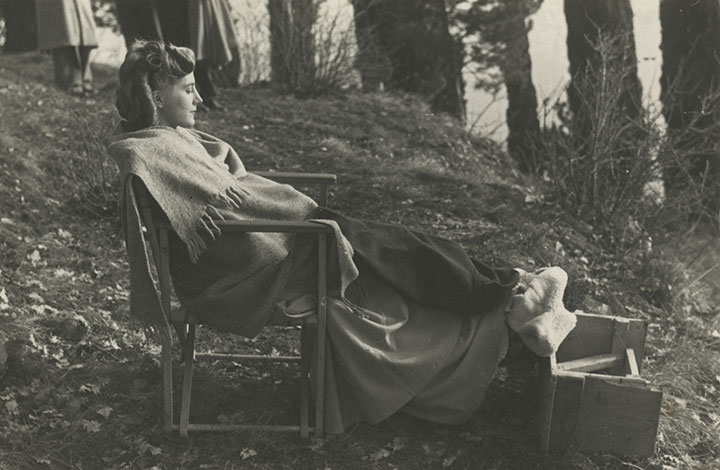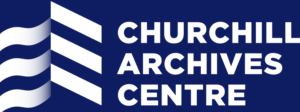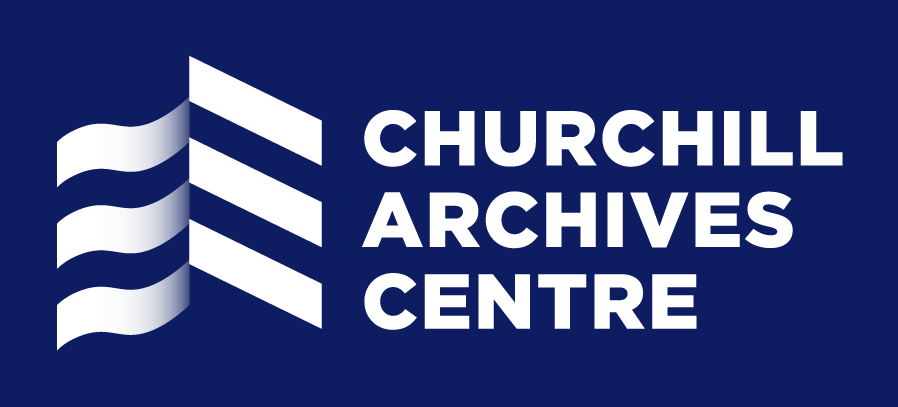Top Ten Collections: Women in the Arts and Literary Life
The Churchill Archives Centre is best known for its collections relating to the art of war, politics, and diplomacy, but — like Winston Churchill himself, a Nobel laureate and keen amateur painter — they also have a more creative side.
In fact, the papers of female non-fiction writers, actresses, playwrights, and photographers, as well as women’s unpublished literary manuscripts, can be found in many of the Archives Centre’s 600 collections. Occasionally deposited with the papers of their husbands, they provide a glimpse into the histories of women’s taste, creative influences, education, and social worlds.
Part of a series exploring women’s personal papers in the Churchill Archives Centre’s collections, these lists are not exhaustive and provide a very subjective window onto some of our personal highlights. Please get in touch with the team if you have any questions about the collections the Archives Centre holds relating to women’s history, or if you would like to make an appointment to consult any of these collections in the reading room.
10 Edith Balfour Lyttelton (1865-1948)
Edith Balfour was educated privately and moved in the aristocratic circle of friends known as the ‘Souls’, which included Margot Tennant (later Asquith), Violet Manners, Madeline Wyndham, and Alfred Lyttelton, whom she later married. She wrote a novel, The Sinclair Family (1926), and an account of her travels in the Far East and India, Travelling Days (1933). Encouraged by her close friendship with George Bernard Shaw, she also wrote seven plays, two of which were inspired by her campaigns against sweated labour. After 1918 she lobbied for the foundation of a national theatre in London.
Highlights:
- CHAN II/3/1-29: Correspondence from Edith and Alfred Lyttelton to friends and family, including Margot Asquith, Laurence Housman, Henry James, George Bernard Shaw, and John Ruskin
- [CHAN I/6/1-12: Edith Lyttelton’s unpublished literary manuscripts and drafts, including travel diaries and accounts of her psychic experiences
9 Lady Diana Cooper (1892-1986)
Diana Cooper was one of the leaders of an aristocratic and intellectual group known as ‘The Coterie’, and a famously glamorous social figure. During the First World War she tried her hand at journalism, as editor of the magazine Femina and as a popular columnist. In 1923, she embarked on a limited, but extremely lucrative, theatrical career, starring as the Madonna in Max Reinhart’s play The Miracle. She was to tour with the production for the next twelve years in Britain, Europe, and the United States, and the money from this enabled her husband, Duff Cooper, to leave his job at the Foreign Office and embark on a political career. She ran the British Embassy in Paris when Duff became Ambassador to France in 1944, queen of a brilliant group of actors, writers, and artists called ‘La Bande’, not unlike the ‘Coterie’ of 30 years before.
Highlights:
- · DIAC 5/6: Photograph album from The Miracle, given by the producer Charles Cochran, 1932
- · DIAC 3/10: Articles by Lady Diana on subjects including the dangers of flying, the pleasures of picnics and dressing up, and travel; correspondence with editors; and fan mail, c. 1918-1980
8 Sarah Churchill (1914-1982)
Sarah was the third of Winston and Clementine’s Churchill’s children, nicknamed ‘Mule’ by her family for her stubborn nature. She trained in ballet and pursued a career as a dancer and actress in theatre and films in Britain, Italy, and the United States. She lived in Hollywood during the late 1940s and early 1950s with her second husband, the celebrity photographer Antony Beauchamp. Later, as her life was increasingly dogged by personal losses, illness, and alcoholism, she turned to writing, publishing a memoir of her father and her own frank autobiography, Keep on Dancing.
Highlights:
- · SCHL 1/4: Sarah Churchill’s correspondence with her close friend Villiers David, the dilettante and artist, including letters sent from film sets in the UK and USA
- SCHL 6/2/12-20: Photographs of Sarah Churchill on the set of theatre, television, and film productions, c. 1946-56


7 Virginia Smith Crawford (1862-1948)
The daughter of a shipping magnate and a society hostess, both art collectors and patrons of the Pre-Raphaelites, Virginia Crawford was educated partly in Lausanne, where she acquired an interest in literature and a talent for European languages. After her divorce in 1886, she converted to Catholicism and supported herself through prolific work as a journalist, including writing for the newspaper editor W. T. Stead; translating; historical research; and social work. She also travelled widely in Italy, where she compiled art historical works on Fra Angelico and Raphael. During the interwar period she served as a Labour Party councillor on Marylebone borough council, campaigned for equal franchise rights for women through the Catholic Women’s Suffrage Society, and published pamphlets warning of the dangers of fascism in Italy.
Highlights:
- REND/12/11/1-4: Articles by Virginia Crawford on religious, social, and cultural subjects, c. 1890s-1940s
- REND 12/1: Letter from Dante Gabriel Rossetti to Mrs Eustace Smith, Virginia Crawford’s mother, enclosing a sonnet written for his painting Pandora (1869)
6 Lotte Meitner-Graf (1899-1973)
Born in Vienna, Lotte Meitner-Graf established her first photographic studio at the age of 21. Through her sister-in-law, the nuclear physicist Lise Meitner, she met and began to photograph a number of European academics, cultivating a distinctive style of black-and-white portraiture which earned her acclaim on both sides of the Atlantic. Following the German annexation of Austria, Meitner-Graf relocated with her family to escape persecution in London, where she reopened her studio in Mayfair. Her subjects included eminent figures from the worlds of science, classical music, theatre, and the arts, such as Marian Anderson, Bertrand Russell, Benjamin Britten, Max Planck, Dorothy Hodgkin — and ceramics by Lucie Rie.
Highlights:
- MTNR 8/5/1, 3-5: Large collection of portrait photographs of Lise Meitner by Lotte Meitner-Graf taken in London and Austria, c. 1920s-60s
- BORN 6/1/2: Portrait photograph of Professor Max Born by Meitner-Graf
- HLSM 12/8/5: Portrait photograph of Lord Hailsham by Meitner-Graf; Hailsham’s archive also contains correspondence with Lotte
5 Helen Maud Cam (1885-1968)
The daughter of a headmaster, Helen Cam graduated from Royal Holloway College, University of London, with a BA in 1902. After a period as a schoolmistress, she returned to Royal Holloway as a lecturer in History. She moved to Girton College, Cambridge, in 1921. A leading authority on medieval law and local government, she was active in local politics in Cambridge and became a benefactor of the Romsey Labour Club. In 1948 she became the first woman to hold a chair at Harvard, and received a CBE in 1957 for her services to education. Professor Cam donated a collection of papers relating to her work in academia after the Second World War to the Churchill Archives Centre in 1967; her personal papers are held at Girton College.
Highlights:
- HCAM 2/2: Papers on the status of women and campaigns for equal rights in Britain and the USA, c. 1947-1953
- HCAM 4/2: Papers on the arts: poetry, exhibitions, concerts, and journalism
4 Betty Behrens (1904-1989)
Betty Behrens was privately educated by governesses before winning a scholarship to read History at Oxford. She became a University Lecturer in History at Cambridge in 1938, aged just 34, and in later life campaigned for more women to be appointed to full-time lectureships (as opposed to precarious teaching contracts) in her faculty. She devoted her life to academic study, publishing her last book in 1985, at the age of 81. Her papers include reading notes on European history, reviews and publications, and notes for an unpublished autobiography. A more detailed catalogue of these papers is available on request from Churchill Archives Centre.
Highlights:
- BEHR Acc. 1848: Correspondence between Behrens and her husband, E.H. Carr
3 Mary Agnes Hamilton (1882-1966)
As well as a distinguished career in Labour politics and the civil service, Mary Agnes Hamilton published ten novels, two memoirs, several political biographies of figures in the labour movement, and dozens of articles for literary magazines and periodicals.
Highlights:
- HMTN 1/5: Diary entry on a lunch with Graham Greene at the Ministry of Information, during which they discussed turning their colleagues into characters in a novel, 1941
- HMTN 1/12: Diary entries include Hamilton’s reflections on the changes to ‘the novel and the individual’ in British society during the Second World War, 1945

2 Mary Borden (1886-1968)
Mary Borden was born in Chicago in 1886 and earned a BA from Vassar College in 1907. She served as a director of mobile field hospitals in France in both World Wars, for which she received military medals for bravery. She drew on her experiences of war for her poetry and several of her novels. In November 2018 her poem ‘Sonnets to a Soldier’ was used as the basis for the Beyond the Deepening Shadow soundscape for the Armistice Centenary at the Tower of London. Borden’s papers are kept with those of her second husband, Sir Edward Spears, whom she met on the Western Front in 1914.
Highlights:
- SPRS 11/1/1: Love letters from Mary Borden to Edward Spears, with original manuscript copies of her war poetry, c. 1913-17
- SPRS 11/5/1: Press cutting album containing reviews of Mary Spears’s books, c. 1916-25
1 Sasha Moorsom Young (1931-1993)
Sasha Moorsom was one of the BBC’s first women producers, and helped to introduce the work of Philip Larkin, Jean Rhys, and Ted Hughes to wider audiences through her work creating documentaries and dramas. In 1958, she invited Michael Young and Peter Willmott to turn their seminal work of sociology, Family and Kinship in East London, into a radio programme featuring original music and voices recorded on the streets in Bethnal Green. She left the BBC when she married Michael Young, and combined raising two children with work as a writer and translator. Her archive contains 50 files of her literary papers, including short stories, plays, articles, and poetry.
Highlights:
- YONG 2/6: Personal correspondence with writers including Thom Gunn, Eugène Ionesco, Colin MacInnes, and Karl Miller
- YONG 4/1/1-5: ‘BBC Papers’, including transcripts of BBC programmes produced by Sasha Moorsom
- YONG 4/7: Correspondence with Jim Ede at Kettle’s Yard, Cambridge, 1982-85
— Heidi Egginton, November 2021

